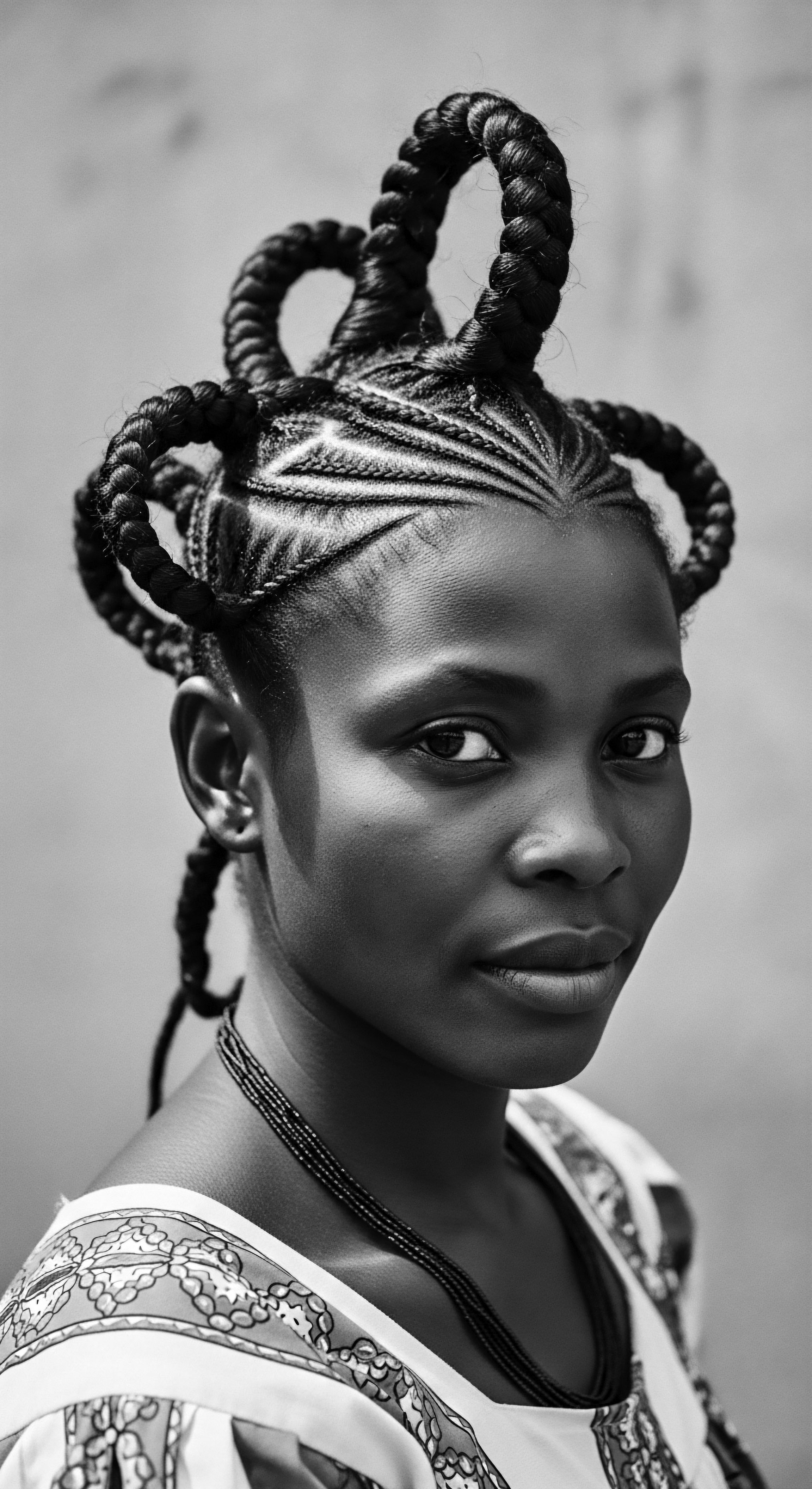
Fundamentals
The conversation surrounding hair, especially textured hair, extends beyond mere aesthetics; it delves into realms of heritage, identity, and wellness. To speak of Metallic Dyes is to invite a contemplation of chemistry, certainly, but also to consider the subtle whispers of history within each strand.
At its core, a Metallic Dye refers to a particular class of hair colorants, distinct from the synthetic formulations dominating today’s market. These colorants historically relied upon Metallic Salts, such as lead acetate, silver nitrate, or bismuth citrate, to impart color upon the hair fiber. Unlike modern oxidative dyes that penetrate the hair shaft and create color through chemical reactions within the cortex, metallic dyes operated by depositing layers of metallic compounds onto the hair’s external surface. This process initiated a gradual darkening of the hair, often resulting in shades ranging from dark brown to black, accompanied by a distinctive, often reflective, metallic sheen.
Metallic Dyes, in their historical context, represent an early chemical intervention in hair aesthetics, depositing metallic layers onto the hair’s surface rather than altering its internal structure.
Understanding this foundational principle is vital. Imagine the hair strand as a cherished family heirloom, each fiber a repository of stories. When a metallic dye was applied, it did not seek to change the very composition of that heirloom, but rather to drape it in a new cloak, a metallic veil. This application process was typically gradual, requiring repeated use to build the desired depth of color.
Think of it as slowly polishing a copper pot, with each successive rub bringing forth a deeper luster. This slow transformation could, for some, offer a discreet method of covering signs of time, like grey hairs, without an abrupt change that might draw undue attention.
Early adoption of these dyes, particularly in the 19th and early 20th centuries, emerged from a burgeoning beauty industry responding to a desire for youthful appearances. Advertising materials from this era frequently depicted ideals of thick, vibrant hair, promising that various tonics and dyes could restore or maintain such desirable qualities. The intention behind these metallic formulations was simple ❉ to offer a perceived natural-looking solution for darkening hair, without the immediate, dramatic shift that later synthetic dyes would allow. This gradual deposition meant a less uniform color compared to modern dyes, sometimes resulting in hues that could appear flat or even exhibit an unintended green, purple, or reddish cast depending on the metal used and the hair’s inherent chemistry.
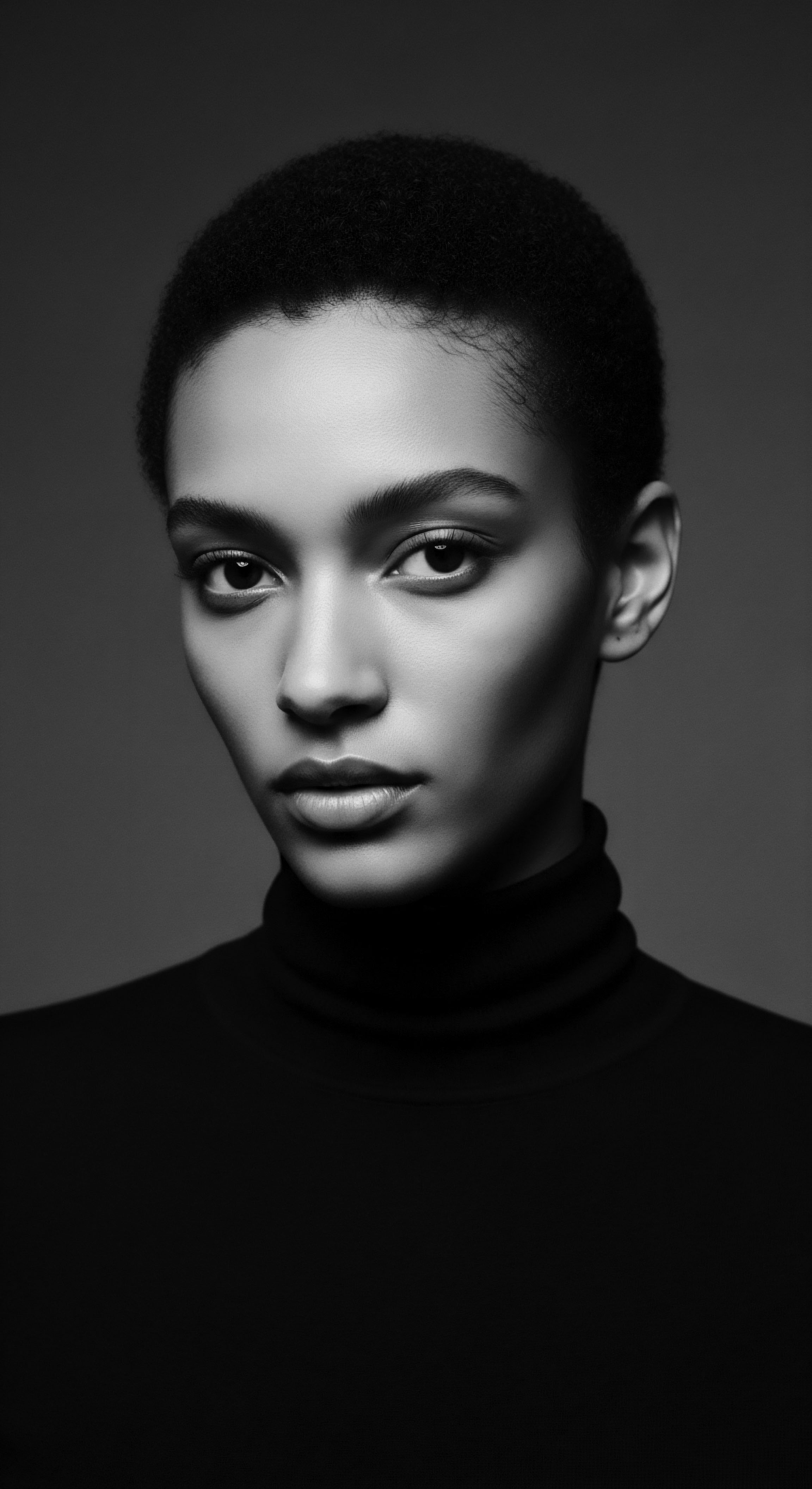
The Elemental Connection
The materials at the heart of metallic dyes were quite literally elements drawn from the earth. Lead, silver, and bismuth, while familiar to us as metals, found their way into hair preparations as soluble salts. When these salts encountered the sulfur-containing amino acids within the keratin structure of hair, a chemical reaction ensued, forming metallic sulfides.
These sulfides were the colored compounds that adhered to the cuticle, forming the external layer of pigmentation. This interaction highlights a fascinating, if sometimes problematic, early intersection of elemental science and hair adornment.
This elemental connection carries a certain resonance, reminding us that even in endeavors to alter our appearance, we remain tethered to the fundamental building blocks of our world. Ancestral practices for coloring hair, predating these chemical inventions, often drew from plant-based sources or earthen pigments, embodying a different kind of relationship with nature’s palette. The shift towards metallic salts represented a step into a new era of chemical manipulation, moving beyond the direct botanical extractions our forebears might have employed.
For many individuals with textured hair, the advent of such chemical solutions, including metallic dyes, contributed to a complex landscape of choices. While ancestral practices favored natural oils, butters, and herbs for moisture retention and scalp health, the allure of conforming to prevailing beauty standards often led to the exploration of these newer, sometimes harsher, products. It becomes clear that even a simple definition of metallic dyes opens a pathway to considering broader societal currents and their impact on personal care rituals.

Intermediate
Transitioning beyond the initial grasp of metallic dyes, we encounter a more complex interplay of chemical action and the unique properties of textured hair. The precise mechanism by which these metallic compounds interacted with the hair fiber merits closer examination, particularly when viewed through the lens of hair health and the aspirations of communities with textured hair.
Metallic dyes operate on the principle of progressive color deposition. Applied repeatedly over days or weeks, the metallic salts slowly reacted with the hair’s inherent keratin. Hair, a resilient protein fiber, possesses a high sulfur content, primarily within its disulfide bonds. These bonds are fundamental to hair’s structural integrity, contributing to its strength, elasticity, and distinctive curl pattern.
When metallic salts came into contact with these sulfur atoms, new compounds formed—Metallic Sulfides—which are insoluble and colored. Lead acetate, for instance, would form lead sulfide, a black compound. Silver nitrate would yield silver sulfide, also dark. This gradual process created a color that deepened with each application, often lauded for its ‘natural’ progression.
The interaction of metallic salts with hair’s inherent sulfur creates a distinct, external layer of color, a stark contrast to the internal changes wrought by modern dyes.
However, this superficial coating posed inherent limitations and presented specific challenges, especially for textured hair. Unlike oxidative dyes which form color molecules within the hair cortex, metallic dyes built up on the outside of the cuticle. This accumulation could lead to a dull, opaque appearance over time, losing any initial luster and often resulting in brassy or unnatural off-tones. Imagine a vibrant silk thread, then consider it coated repeatedly with a thin, metallic paint; its innate flexibility and sheen would inevitably diminish.

Implications for Hair Structure
The layer of metallic salts encasing the hair shaft presented a significant barrier for any subsequent chemical processes. Procedures like permanent waving (perms) or lightening (bleaching), which rely on chemicals penetrating the cuticle and altering the internal disulfide bonds, would often yield unpredictable and damaging results. The metallic residue could react violently with the peroxide in lighteners, causing excessive heat, uneven color, or even severe hair damage.
This chemical incompatibility became a real impediment for individuals who might desire a change in texture or a different hair color later on. Hair treated with metallic dyes became, in essence, a chemically ‘locked’ canvas, resistant to further artistic expression without incurring substantial risk.
For communities with textured hair, this aspect carried particular weight. Hair care practices in Black and mixed-race communities often involve a diverse range of styling, from braiding and twisting to pressing and chemical straightening. The pursuit of different styles, sometimes influenced by prevailing societal beauty standards that favored smoother textures, led many to seek out chemical straighteners. The combination of metallic dyes and these texture-altering processes could lead to compounded damage, creating brittle, weak strands more susceptible to breakage.
Consider the historical context ❉ In the early 20th century, as commercial hair products became more widely available, Black women and men, navigating societal pressures often tied to Eurocentric beauty norms, sought various solutions for their hair. While products like hot combs and chemical relaxers gained prominence for texture alteration, dyes also found their place. The potential harm from these early chemical concoctions, including those with metallic compounds, was often downplayed or unknown to the consumer. The choices made were not simply cosmetic; they were often strategies for self-presentation and survival within prevailing social structures.
Here, we pause to acknowledge the ancestral wisdom that emphasized nurturing hair with natural ingredients like shea butter, coconut oil, and various herbs for moisture and strength. These practices stood in quiet defiance of the harsh chemical interventions that began to proliferate. The tender thread of ancestral care traditions sought to fortify the hair’s inherent resilience, a stark contrast to the sometimes destructive path laid by early chemical dyes.
A deeper understanding of metallic dyes necessitates not only grasping their chemical functions but also appreciating the historical conditions under which they were utilized. This understanding provides perspective on the delicate balance between appearance, well-being, and the enduring quest for self-expression through hair.
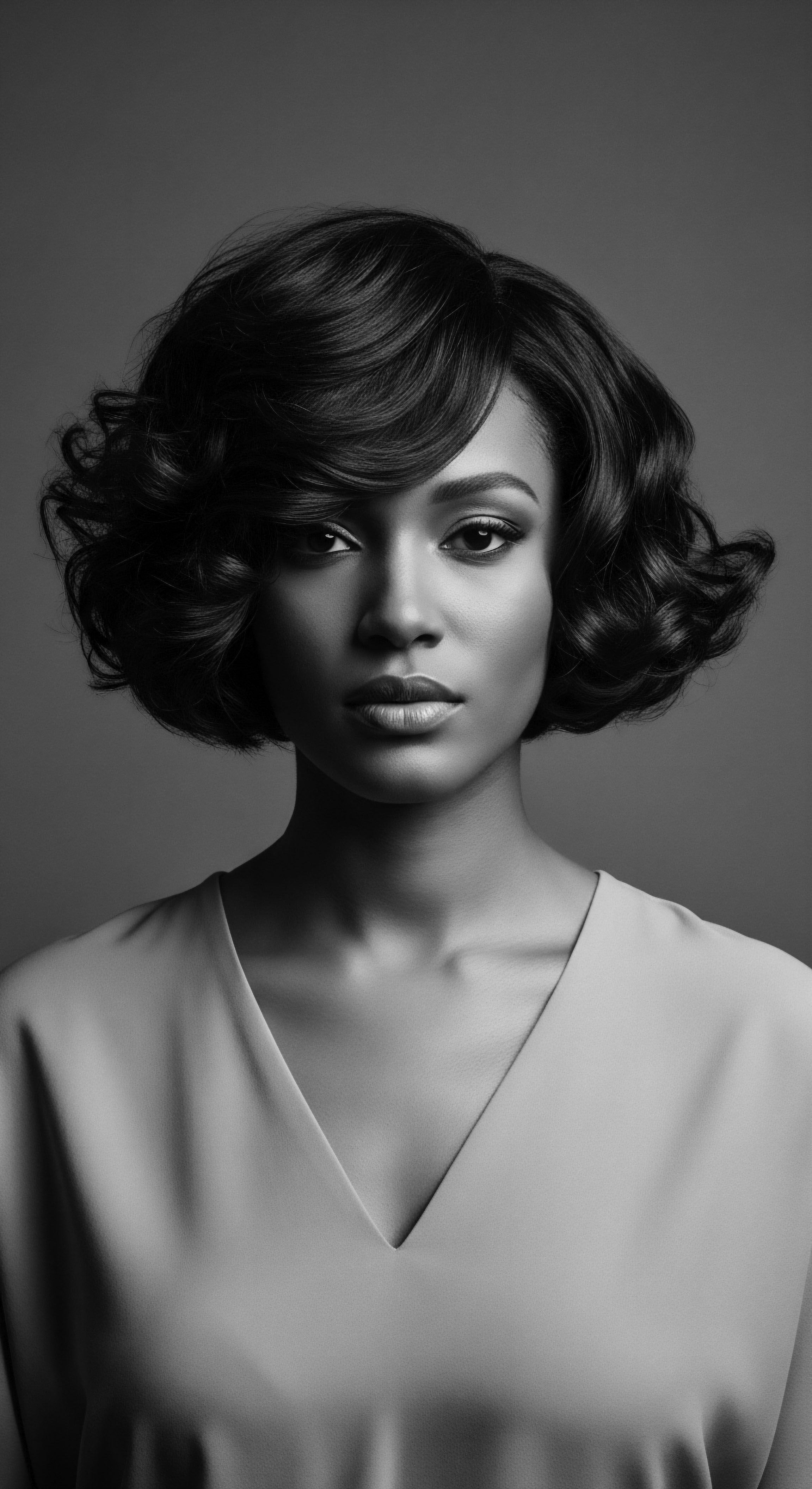
Academic
To approach the concept of Metallic Dyes from an academic vantage point demands a precise articulation of their fundamental characteristics, their historical trajectory, and their socio-scientific implications, particularly within the continuum of textured hair heritage. A Metallic Dye, in the rigorous discourse of cosmetic chemistry and historical dermatology, constitutes a category of hair colorants whose chromogenic properties derive from the deposition of insoluble metallic compounds, primarily sulfides or oxides, onto the external surface of the hair shaft. This coloration is a product of a chemical reaction between the soluble metallic salts present in the dye formulation (e.g. lead acetate, silver nitrate, bismuth citrate, or copper sulfate) and the sulfur atoms within the cysteine residues of the hair’s keratin protein.
This oxidative process, occurring upon exposure to air or through the inclusion of reducing agents, forms a metallic film that gradually darkens the hair, typically achieving shades of black or dark brown over repeated applications, distinguished by a characteristic lack of vibrancy and often a dull, opaque finish. The mechanism is surface-adsorptive rather than penetrative, differentiating them fundamentally from modern oxidative (permanent) or direct (semi-permanent) dyes that interact with or form color molecules within the hair’s internal cortex.
The historical application of metallic dyes, particularly those containing lead salts, can be traced to antiquity, though their commercial proliferation intensified during the 19th and early 20th centuries. These formulations offered a deceptively simple solution for concealing graying hair, appealing to a broad demographic seeking a gradual, less conspicuous color change. However, this apparent simplicity belied a cascade of profound interactions with the hair fiber and, more critically, with subsequent chemical treatments, rendering the hair notoriously difficult to process without significant compromise to its integrity. The metallic buildup created a physical and chemical barrier, reacting unpredictably with the peroxides or reducing agents common in salon services like lightening or permanent waving, leading to adverse outcomes such as extreme heat generation, metallic off-tones (e.g.
green from silver, red from copper, purple from lead), and severe structural damage to the hair. This complex chemical behavior underscores a pivotal challenge metallic dyes presented to hair care professionals and, by extension, to the individuals whose hair bore their imprint.

Echoes from the Source ❉ Chemistry and Early Applications
The elemental biology of hair provides the canvas for these metallic interactions. The keratinocytes that form the hair fiber are rich in sulfur-containing amino acids, notably cysteine, which forms disulfide bonds crucial for hair’s structural resilience and curl definition. When lead acetate, for instance, was applied, its lead ions reacted with the sulfur in the keratin to form lead sulfide, an insoluble black precipitate that coated the hair. This progressive deposition meant that the color built layer by layer on the cuticle, leading to a surface-level pigmentation that could feel stiff or appear flat, lacking the dimensional light reflection characteristic of healthy hair.
From ancient times, humans have sought to alter their hair’s hue. Early practices in Egypt and other regions utilized plant-based dyes like Henna and Indigo, or mineral pigments such as ochre and various clays. These ancestral methods often involved a deep understanding of botanical properties and a holistic approach to hair wellness, emphasizing nourishment alongside color.
The introduction of metallic dyes represented a significant shift from these more organic, often ritualistic, applications. Instead of working in harmony with the hair’s inherent nature, metallic dyes imposed an external coating, a departure that foreshadowed later chemical advancements, not all of which prioritized hair vitality.
For communities within the African diaspora, the journey of hair has consistently been intertwined with narratives of adaptation, resistance, and identity, often shaped by prevailing beauty standards. While the immediate ancestral practices focused on natural ingredients for maintenance and styling, the advent of commercial chemical products, including early dyes and straighteners, introduced new complexities. Physicians, even in the early 20th century, voiced concerns about toxic ingredients, such as lead, in commercial hair tonics and dyes.
The historical trajectory of metallic dyes intersects with textured hair experiences, revealing how chemical interventions, often problematic, became intertwined with quests for self-expression amidst rigid societal beauty norms.
A compelling historical instance that illuminates the precarious relationship between early chemical hair treatments and the health of textured hair involves the widespread use of various hair alterants in the early 20th century. While direct, specific data on metallic dye usage within Black communities at the time is scarce due to historical record-keeping biases, the broader context of chemical hair treatments reveals significant patterns. As documented by the National Museum of American History, by the early 1900s, commercial products specifically developed for, and often by, African Americans gained immense popularity, including hair “growers” and pressing oils. These products, alongside the emerging popularity of hot combs and later chemical relaxers, aimed to enable Black women to style their hair into fashions that often aligned with Eurocentric ideals, despite the inherent risks.
The critical point here is that while not all were metallic dyes, the era was characterized by the introduction of chemical agents into hair care that frequently led to adverse outcomes. For example, research indicates that early chemical straighteners could cause severe hair breakage and sometimes even dyed the hair red, underscoring the unpredictable and damaging nature of many chemical interventions of the time. This period represents a crucial confluence where the desire for aesthetic conformity met the nascent, often hazardous, chemical solutions of the day. The risks associated with metallic dyes – dullness, brittleness, and particularly their disastrous interactions with other chemical processes like perms or bleaches – meant that individuals with textured hair who might use a metallic dye for gray coverage, and then later seek a chemical straightening service, could face compounded damage, leaving their hair significantly compromised. The cumulative chemical exposure from such products, including metallic dyes, was a quiet, yet persistent, contributor to scalp damage and hair integrity challenges within these communities.
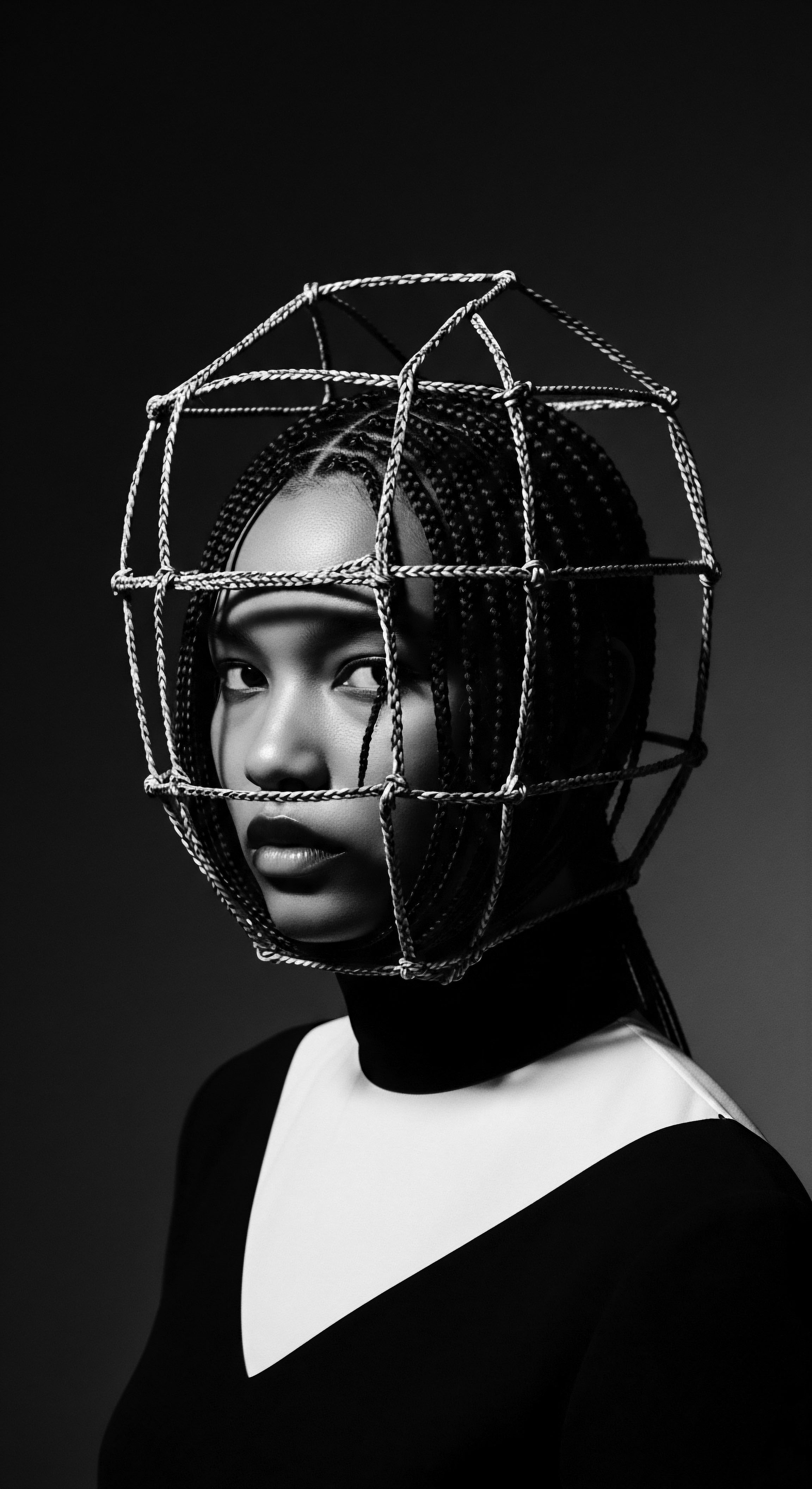
The Tender Thread ❉ Living Traditions and Hair Integrity
The interaction of metallic dyes with the inherent structure of textured hair warrants a more nuanced discussion. Textured hair, with its unique helical structure, varying porosity, and differing moisture needs, reacts uniquely to chemical treatments. The cuticle layers of textured hair, particularly tighter curl patterns, can be more susceptible to lifting and damage from harsh chemicals, leaving the inner cortex exposed. The non-penetrative nature of metallic dyes, while seemingly less aggressive than oxidative dyes, meant a superficial coating that could exacerbate existing dryness or impede the absorption of nourishing oils, a cornerstone of traditional Black hair care.
Consider the ancestral emphasis on conditioning and protection. In many African cultures, hair was revered, adorned with natural butters, herbs, and oils, and styled in intricate braids and twists not only for aesthetic purposes but for protection against environmental elements and as expressions of social status, tribal affiliation, and spiritual connection. These practices fostered the hair’s strength and moisture retention, qualities often jeopardized by metallic dye application. The very essence of these protective styles and nourishing rituals stood in quiet opposition to the drying, coating effects of metallic salts.
The impact of metallic dyes, therefore, extends beyond mere chemical interaction; it enters the realm of hair wellness. The build-up of metallic compounds on the hair shaft made it difficult for hair to absorb moisture effectively, leading to increased brittleness and breakage. For textured hair, already prone to dryness due to its coiled structure, this was a significant detriment.
The metallic film also rendered hair unresponsive to subsequent professional salon treatments, creating a frustrating dilemma for those seeking further style alterations. This meant a legacy of compromised hair, often necessitating drastic measures like cutting the dyed portions, a silent testament to the long-term consequences of such chemical choices.
- Lead Acetate ❉ Historically prevalent, reacting with sulfur to form black lead sulfide. Known for gradual darkening.
- Silver Nitrate ❉ Employed for darker shades, producing silver sulfide. Could impart a greenish hue over time.
- Bismuth Citrate ❉ Used to achieve darker tones, though less common than lead or silver.
- Copper Sulfate ❉ Less frequently the primary colorant, but copper can be a problematic metal that binds to hair, causing damage and unreliable color results, especially with modern dyes.

The Unbound Helix ❉ Identity, Futures, and Evolution
The journey of textured hair through history is a testament to its profound symbolic meaning, serving as a powerful medium for identity and self-expression. The choices surrounding hair color, including the use (or avoidance) of metallic dyes, reflect broader cultural currents and individual narratives. While ancestral practices celebrated the hair’s inherent textures and adorned them with natural pigments and embellishments, the historical imposition of Eurocentric beauty standards often pressured individuals to chemically alter their hair. Metallic dyes, as part of the early chemical toolkit, became another option in this complex landscape, sometimes used as a means of conforming to ideals of smooth, dark hair, particularly for covering gray.
This pursuit of altered aesthetics was not without consequence. The documented adverse effects of metallic dyes – from scalp irritation to the severe weakening of the hair shaft – contributed to a cycle of damage and repair that many with textured hair experienced. The cumulative impact of such treatments often necessitated extensive restorative practices, echoing the ancestral emphasis on nourishing the hair, now perhaps with a heightened awareness of its vulnerability to harsh chemicals.
| Characteristic Primary Composition |
| Ancestral/Natural Colorants Plant extracts (e.g. henna, indigo, turmeric), natural earths (e.g. ochre). |
| Early Metallic Dyes Metallic salts (e.g. lead acetate, silver nitrate, bismuth citrate). |
| Characteristic Mechanism of Action |
| Ancestral/Natural Colorants Stains or coats hair cuticle; some penetrate minimally. Often acts as a conditioner. |
| Early Metallic Dyes Reacts with hair's sulfur to deposit insoluble metallic compounds on surface. |
| Characteristic Color Range |
| Ancestral/Natural Colorants Earth tones, reds, blacks, some yellows/golds. Limited synthetic vibrancy. |
| Early Metallic Dyes Primarily dark browns to black; can produce undesirable off-tones (green, purple). |
| Characteristic Impact on Hair Health |
| Ancestral/Natural Colorants Often conditioning, adds strength and shine; supports natural hair integrity. |
| Early Metallic Dyes Can cause dullness, brittleness; impedes future chemical services; potential toxicity. |
| Characteristic Cultural Context |
| Ancestral/Natural Colorants Deeply tied to identity, status, community ritual, spiritual connection. |
| Early Metallic Dyes Emerging commercial product, often for gray coverage, influenced by evolving beauty standards. |
| Characteristic The shift from natural, heritage-grounded practices to early commercial metallic dyes marked a departure in both chemical interaction and the holistic approach to hair wellness. |
The dialogue surrounding metallic dyes also prompts consideration of contemporary metallic hair colors. Modern “metallic hair colors” refer to fashion-forward shades that impart a shimmering, iridescent effect, achieved through advanced synthetic pigments and light-reflecting technologies, not metallic salts. This distinction is critical for hair practitioners and consumers, as the modern metallic trend carries aesthetic goals very different from the earlier formulations and, crucially, avoids the chemical incompatibilities and potential toxicities associated with traditional metallic salt dyes. The evolution in terminology reflects a fascinating journey of chemistry and perception, where a historical term for a problematic product has been re-imagined for a vibrant, contemporary aesthetic.
The academic exploration of metallic dyes therefore contributes to a broader understanding of hair science, historical cosmetic practices, and their socio-cultural context. It allows for a critical examination of how innovation, even when intended for superficial enhancement, can carry long-term implications for health and well-being, particularly for communities whose hair has historically been a site of both cultural expression and external scrutiny. The challenges posed by metallic dyes in the past serve as an enduring lesson in the pursuit of beauty, reminding us of the profound responsibility to prioritize the vitality of the hair and the individual’s well-being above fleeting trends. The narrative of metallic dyes, therefore, forms a crucial chapter in the grand anthology of textured hair’s resilience and its ongoing conversation with heritage.
This perspective reveals that the choices individuals make about their hair, even concerning a seemingly straightforward product like a dye, are often layered with personal history, communal values, and the silent pressure of societal ideals. Understanding the precise definition and historical impact of metallic dyes, especially on textured hair, provides not only scientific clarity but also deepens our respect for the resilience and adaptability inherent in ancestral hair traditions. The future of hair care, particularly for textured hair, must continue to draw from this rich historical tapestry, affirming practices that honor its unique structure and cultural significance while leveraging scientific advancements that genuinely promote wellness, free from the damaging legacies of the past.
| Chemical Treatment Type Metallic Dyes |
| Common Ingredients (Historical) Lead acetate, silver nitrate, bismuth citrate. |
| Impact on Hair/Scalp (Documented) Dullness, brassiness, brittleness, unpredictable reactions with other chemicals (e.g. perms, bleaches), potential toxicity. |
| Chemical Treatment Type Lye Relaxers |
| Common Ingredients (Historical) Sodium hydroxide. |
| Impact on Hair/Scalp (Documented) Scalp burns, hair breakage, dryness, weakened hair strands, permanent alteration of curl pattern. |
| Chemical Treatment Type Hot Comb Application |
| Common Ingredients (Historical) Heated metal combs, often used with pressing oils. |
| Impact on Hair/Scalp (Documented) Heat damage, breakage, dryness, potential burns if not used carefully. |
| Chemical Treatment Type Many early chemical treatments, including metallic dyes, posed significant risks to hair and scalp health, particularly for textured hair navigating societal pressures for straightened styles. |
The academic pursuit of understanding metallic dyes also touches upon their broader public health implications. The presence of heavy metals in cosmetics, including hair dyes, has been a subject of concern due to the potential for systemic exposure through dermal absorption. While the quantities might be small in modern formulations, historical products often contained higher concentrations, contributing to concerns about cumulative exposure over time. This highlights a crucial intersection of cosmetic practice, public health, and regulatory oversight, reminding us that beauty rituals are never truly isolated from their wider ecological and physiological contexts.
The journey from elemental biology to nuanced hair science, through the lens of metallic dyes, therefore offers an opportunity to appreciate the profound shifts in hair care over centuries. It underscores the ongoing responsibility of chemists and hair artists to prioritize the long-term well-being of the hair and scalp, especially for those with textured hair, whose ancestral practices often contained innate wisdom for maintaining vitality through gentler, more harmonious means. The history of metallic dyes is not just a tale of chemical innovation; it is a profound testament to the enduring human desire for transformation and the critical importance of understanding every layer of our beauty practices.
- Chemical Instability ❉ Metallic dyes can react unpredictably with various salon chemicals, leading to irreversible hair damage and unwanted color shifts.
- Surface Build-Up ❉ The external coating created by metallic salts prevents proper penetration of conditioners and other treatments, leaving hair dry and brittle.
- Color Limitations ❉ Restricted to dark, often dull, shades, metallic dyes offer little versatility for aesthetic expression.
- Potential Toxicity ❉ Historical formulations containing lead carried inherent health risks with prolonged exposure.
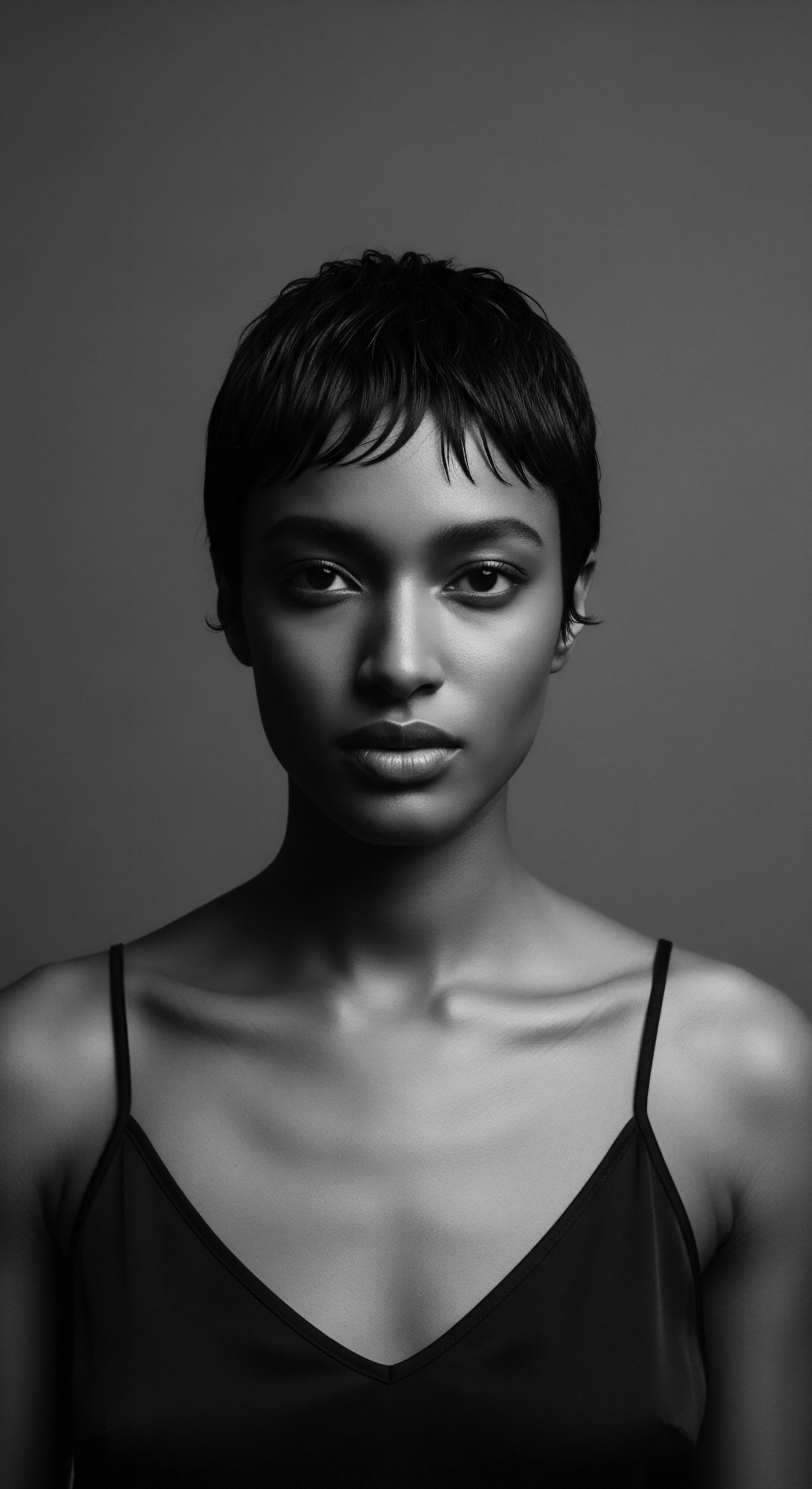
Reflection on the Heritage of Metallic Dyes
As we draw our exploration of Metallic Dyes to a close, a quiet contemplation unfolds—a reflection on how these historical formulations resonate with the enduring story of textured hair, its boundless heritage, and its sacred care. The very term “Metallic Dyes,” though rooted in specific chemistry, calls forth a deeper meaning when viewed through the lens of ancestral wisdom and the lived experiences of Black and mixed-race communities. It becomes a marker in the grand narrative of how hair has been adorned, altered, and understood across generations.
The initial allure of metallic dyes, promising gradual concealment of gray, speaks to a timeless human desire for timelessness itself, a wish to preserve a youthful appearance. Yet, for textured hair, these early chemical innovations often presented unforeseen challenges. The wisdom passed down through generations—a wisdom steeped in the nurturing power of natural butters, the protective embrace of braids, and the communal strength found in shared styling rituals—often stood in gentle contrast to the harsh realities of chemicals that promised transformation but delivered brittleness. These ancestral practices, honed over centuries, prioritized the vitality of the hair, treating it as a living extension of self, a connection to lineage, a sacred antenna to the spiritual world.
The story of metallic dyes, therefore, becomes a poignant chapter in the larger volume of hair history for Black and mixed-race individuals. It highlights a period where the pursuit of beauty, sometimes influenced by external societal pressures, intersected with emerging chemical technologies that were not always in harmony with the unique needs of textured hair. It reminds us of the delicate balance between aesthetic aspiration and the preservation of hair health, a balance that countless individuals navigated with courage and ingenuity.
What lessons do these metallic echoes from the past offer for our present and future? They prompt us to honor the innate resilience of textured hair, celebrating its diverse forms and affirming its intrinsic beauty. They encourage a discerning eye towards modern innovations, urging us to question ingredients and methodologies, always seeking harmony with the hair’s natural cadence and integrity. The tender thread of ancestral knowledge, with its emphasis on nourishment and protection, remains a guiding light, prompting us to approach hair care not as a burden, but as a ritual of self-love, a connection to a deep, abiding heritage.
Ultimately, the definition of Metallic Dyes, steeped in its scientific underpinnings and historical applications, transcends mere technicality. It transforms into a living, breathing archive, inviting us to reflect on the choices made, the lessons learned, and the enduring spirit of textured hair. This reflection grounds us, allowing us to appreciate how far our understanding of hair has progressed, while never forgetting the wisdom that was always present in the practices of our forebears. It beckons us to continue shaping a future where every helix, unbound and celebrated, freely expresses its magnificent, inherited story.

References
- American Hair Loss Association. (n.d.). Hair Dye ❉ A Look at the Harmful Chemicals. (Not a book, but common reference for chemical issues in hair dye)
- Byrd, A. D. & Tharps, L. D. (2014). Hair Story ❉ Untangling the Roots of Black Hair in America. St. Martin’s Griffin.
- Guenther, J. P. (1990). The Hair Care Handbook ❉ A Guide to the Science of Hair. Van Nostrand Reinhold.
- Hunter, M. (2011). Buying Hair ❉ The Truth About Hair Extensions. W. W. Norton & Company.
- Koop, M. (2013). The History of Hair ❉ Fashion and Adornment. Dover Publications.
- Lax, E. (2007). The Art of African American Hair ❉ From the Historical to the Hip. Rizzoli.
- Mahdavi, N. (2003). The Science of Hair Care. CRC Press.
- Poucher, W. A. (1975). Perfumes, Cosmetics and Soaps ❉ The Raw Materials of Perfumery, Cosmetics and Soaps. Springer.
- Rosado, S. (2003). The Grammar of Hair ❉ Identity, Self, and the Black Woman. (Dissertation, University of Massachusetts Amherst).
- Toliver, T. (2014). The Hair Color Manual ❉ A Professional Guide to Haircolor Theory and Service. Milady.
